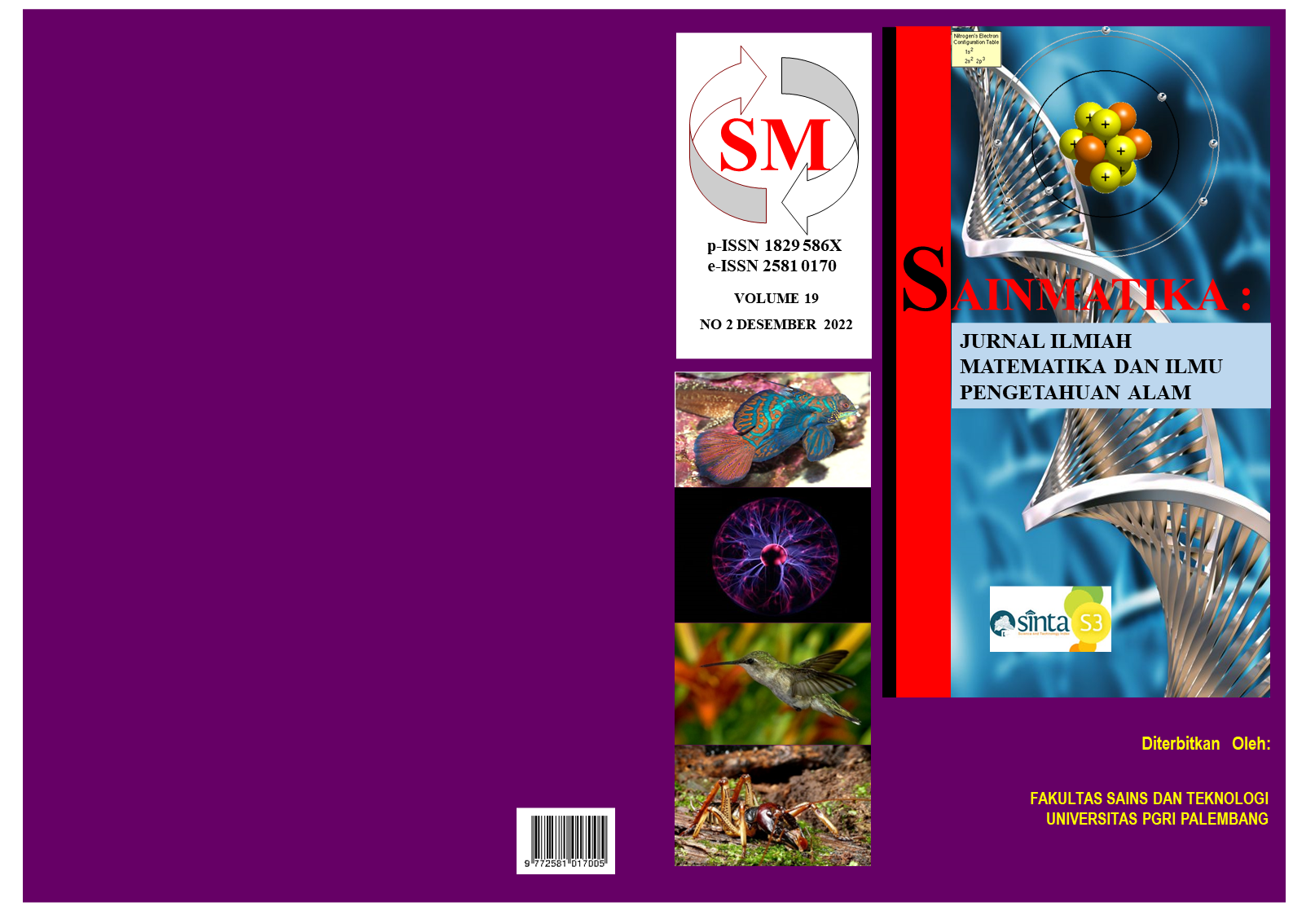Pemanfaatan Limbah Kulit Pisang Raja Nangka sebagai Capping Agent Sintesis Partikel ZnO: Variasi Pelarut Ekstraksi
DOI:
https://doi.org/10.31851/sainmatika.v19i2.9135Keywords:
ZnO, kulit pisang raja nangka, capping agent alami, pelarut ekstraksi, Xanthomonas oryzae pv. oryzaeAbstract
Kemunculan bakteri resisten antibiotik menjadi masalah serius di seluruh dunia. Upaya penanggulangan bakteri resisten antibiotik terus dilakukan, salah satunya dengan penggunaan material berukuran nano. Zink oksida (ZnO) merupakan salah satu partikel yang telah terbukti dapat menghambat pertumbuhan bakteri gram negatif dan gram positif. Dalam mencegah terjadinya aglomerasi pada sintesis ZnO berukuran nanometer dapat ditambahkan capping agent alami berupa senyawa metabolit sekunder pada ekstrak kulit pisang raja nangka. Adapun langkah yang dilakukan adalah: 1) ekstraksi metabolit sekunder kulit pisang raja nangka, 2) uji fitokimia, 3) penentuan kadar total flavonoid dan polifenol, 4) sintesis ZnO dengan capping agent alami ekstrak kulit pisang raja nangka, 5) karakterisasi ZnO, dan 6) uji aktivitas antibakteri ZnO. Hasil analisis kualitatif melalui uji fitokimia serta analisis kuantitatif melalui penentuan kadar total polifenol dan flavonoid menunjukkan bahwa ekstrak kulit pisang raja nangka etanol (96%)-air 2:1 (v/v) memiliki kadar metabolit sekunder yang lebih tinggi dibandingkan ekstrak kulit pisang raja nangka etanol (96%)-air 1:1 (v/v). Partikel ZnO berhasil disintesis menggunakan capping agent alami ekstrak kulit pisang raja nangka. Kadar metabolit sekunder yang berbeda pada masing-masing ekstrak mempengaruhi ukuran, morfologi, dan aktivitas antibakteri ZnO hasil sintesis.
References
Ade, P., Yulis, R., & Sari, Y. (2020). Uji Efektivitas Beberapa Pelarut pada Proses Identifikasi Metabolit Sekunder Kulit Pisang (Musa Paradisiaca) secara Kualitatif. FULLERENE Journal of Chemistry, 5(2), 83–88. https://doi.org/10.37033/fjc.v5i2.196
Aldeen, T. S., Ahmed Mohamed, H. E., & Maaza, M. (2022). ZnO nanoparticles prepared via a green synthesis approach: Physical properties, photocatalytic and antibacterial activity. Journal of Physics and Chemistry of Solids, 160(2022), 1–12. https://doi.org/10.1016/j.jpcs.2021.110313
Ariyani, H., Nazemi, M., Hamidah, & Kurniati, M. (2018). Uji Efektivitas Antibakteri Ekstrak Kulit Limau Kuit (Cytrus hystrix DC) terhadap Beberapa Bakteri. Journal of Current Pharmaceutical Sciences, 2(1), 136–141.
Assidiqi, F. (2021). Sintesis ZnO NPs dengan Prinsip Kimia Hijau Menggunakan Ekstrak Kulit Manggis (Gracinia mangostana l.) sebagai Capping Agent dan Karakterisasinya sebagai Bahan Skincare. Universitas Negeri Malang.
Balouiri, M., Sadiki, M., & Ibnsouda, S. K. (2016). Methods for In Vitro Evaluating Antimicrobial Activity: a Review. Journal of Pharmaceutical Analysis, 6(2), 71–79. https://doi.org/10.1016/j.jpha.2015.11.005
Barman, A. (2015). Review on Biocompatibility of ZnO Nano Particles. Springer India. https://doi.org/10.1007/978-81-322-2256-9_32
Do, Q. D., Angkawijaya, A. E., Tran-Nguyen, P. L., Huynh, L. H., Soetaredjo, F. E., Ismadji, S., & Ju, Y. H. (2014). Effect of Extraction Solvent on Total Phenol Content, Total Flavonoid Content, and Antioxidant Activity of Limnophila aromatica. Journal of Food and Drug Analysis, 22(3), 296–302. https://doi.org/10.1016/j.jfda.2013.11.001
Fatimah, I. (2017). Synthesis of Metal and Metal Oxide Nanoparticles Using Plant Extract: a Review. Jurnal Eksakta, 17(1), 66–85. https://doi.org/10.20885/eksakta.vol17.iss1.art7
Gould, I. M., & Bal, A. M. (2013). New Antibiotic Agents in the Pipeline and How They Can Help Overcome Microbial Resistance. Virulence, 4(2), 185–191. https://doi.org/10.4161/viru.22507
Happy Agarwal, Menon, S., Venkat Kumar, S., & Rajeshkumar, S. (2018). Mechanistic Study on Antibacterial Action of Zinc Oxide Nanoparticles Synthesized Using Green Route. In Chemico-Biological Interactions (Vol. 286, pp. 60–70). Elsevier. https://doi.org/10.1016/j.cbi.2018.03.008
Hasma, H., & Winda, W. (2019). Identifikasi Senyawa Metabolit Sekunder Ekstrak Etanol Kulit Buah Pisang Kepok (Musa paradisiaca L) dengan Metode KLT. Jurnal Kesehatan Manarang, 5(2), 125. https://doi.org/10.33490/jkm.v5i2.176
Hidayati, E. N. (2020). Sintesis Nanopartikel Zink Oksida (NP ZnO) dengan Metode Kopresipitasi Menggunakan Capping Agent Ekstrak Kulit Pisang Candi serta Karakterisasi dan Uji Aktivitas Antibakterinya. Universitas Negeri Malang.
Javed, R., Zia, M., Naz, S., Aisida, S. O., Ain, N., & Ao, Q. (2020). Role of Capping Agents in the Application of Nanoparticles in Biomedicine and Environmental Remediation: Recent Trends and Future Prospects. Journal of Nanobiotechnology, 18(172), 1–15. https://doi.org/10.1186/s12951-020-00704-4
Kibria, A. A., Kamrunnessa, Rahman, M. M., & Kar, A. (2019). Extraction and Evaluation of Phytochemicals from Banana Peels ( Musa sapientum ) and Banana Plants ( Musa paradisiaca ) . Malaysian Journal of Halal Research, 2(1), 22–26. https://doi.org/10.2478/mjhr-2019-0005
Kumar, P. R. A. J., Siva, K., Siva, G., Rao, Y. H., & Rao, Y. H. (2018). Investigation for Phytochemical Compounds in the Plant Material of Rosa indica L. Journal of Advanced Studies in Agricultural, Biological, and Environmental Sciences (JABE), 5(1), 1–13.
Kumar, S. S., Venkateswarlu, P., Rao, V. R., & Rao, G. N. (2013). Synthesis, Characterization, and Optical Properties of Zinc Oxide Nanoparticles. International Nano Letters, 3(30), 1–6.
Lumowa, S. V. ., & Bardin, S. (2018). Uji Fitokimia Kulit Pisang Kepok (Musa paradisiaca L.) Bahan Alam sebagai Pestisida Nabati Berpotensi Menekan Serangan Serangga Hama Tanaman Umur Pendek. Jurnal Sains Dan Kesehatan, 1(9), 465–469. https://doi.org/https://doi.org/10.25026/jsk.v1i9.87
Manasika, A., & Widjanarko, S. B. (2015). Ekstraksi Pigmen Karotenoid Labu Kabocha Menggunakan Metode Ultrasonik (Kajian Rasio Bahan: Pelarut dan Lama Ekstraksi). Pangan Dan Agroindustri, 3(3), 928–938.
Marfu’ah, S., Rohma, S. M., Fanani, F., Hidayati, E. N., Nitasari, D. W., Primadi, T. R., Ciptawati, E., Sumari, S., & Fajaroh, F. (2020). Green Synthesis of ZnO Nanoparticles by Using Banana Peel Extract as Capping agent and Its Bacterial Activity. IOP Conference Series: Materials Science and Engineering, 833(1), 1–6. https://doi.org/10.1088/1757-899X/833/1/012076
Mudalige, T., Qu, H., Van Haute, D., Ansar, S. M., Paredes, A., & Ingle, T. (2018). Characterization of Nanomaterials: Tools and Challenges. In Nanomaterials for Food Applications (pp. 313–353). Elsevier Inc. https://doi.org/10.1016/B978-0-12-814130-4.00011-7
Nitasari, D. W. (2020). Sintesis Nanopartikel Seng Oksida (NP ZnO) Menggunakan Ekstrak Kulit Pisang Tanduk (Musa paradisiaca) sebagai Capping Agent serta Karakterisasi dan Uji Aktivitasnya sebagai Aantibakteri. Universitas Negeri Malang.
Nurlailah, L., & Syamsiah, M. (2018). Aplikasi Asap Cair Turen terhadap Bakteri Xanhtomonas oryzae pv. oryzae Penyebab Hawar Daun Bakteri pada Padi secara In Vitro. Agroscience (Agsci), 8(2), 198–210. https://doi.org/10.35194/agsci.v8i2.485
Rahayu, E., Wonoputri, V., & Samadhi, T. W. (2020). Plant Extract-Assisted Biosynthesis of Zinc Oxide Nanoparticles and Their Antibacterial Application. IOP Conf. Series: Materials Science and Engineering, 823. https://doi.org/10.1088/1757-899X/823/1/012036
Rahman, A., Harunsani, M. H., Tan, A. L., & Khan, M. M. (2021). Zinc Oxide and Zinc Oxide-Based Nanostructures: Biogenic and Phytogenic Synthesis, Properties and Applications. In Bioprocess and Biosystems Engineering (Vol. 44, Issue 7). Springer Berlin Heidelberg. https://doi.org/10.1007/s00449-021-02530-w
Romadhan, M. F. (2015). Sintesis, Karakterisasi dan Pengujian Aktivitas Antimikroba Nanopartikel ZnO. 1–43.
Shaba, E. Y., Jacob, J. O., Tijani, J. O., & Suleiman, M. A. T. (2021). A Critical Review of Synthesis Parameters Affecting the Properties of Zinc Oxide Nanoparticle and Its Application in Wastewater Treatment. Applied Water Science, 11(48), 1–41. https://doi.org/10.1007/s13201-021-01370-z
Siddiqi, K. S., ur Rahman, A., Tajuddin, & Husen, A. (2018). Properties of Zinc Oxide Nanoparticles and Their Activity Against Microbes. Nanoscale Research Letters, 13. https://doi.org/10.1186/s11671-018-2532-3
Silva, B. L. da, Abuçafy, M. P., Manaia, E. B., Junior, J. A. O., Chiari-Andréo, B. G., Pietro, R. C. L. R., & Chiavacci, L. A. (2019). Relationship Between Structure and Antimicrobial Activity of Zinc Oxide Nanoparticles: an Overview. International Journal of Nanomedicine, 14, 9395–9410. https://doi.org/10.2147/IJN.S216204
Singh, P., Kim, Y. J., Zhang, D., & Yang, D. C. (2016). Biological Synthesis of Nanoparticles from Plants and Microorganisms. Trends in Biotechnology, 34(7), 588–599. https://doi.org/10.1016/J.TIBTECH.2016.02.006
Suganthi, K. S., & Rajan, K. S. (2012). Effect of Calcination Temperature on the Transport Properties and Colloidal Stability of ZnO-water Nanofluids. Asian Journal of Scientific Research, 5(4), 207–217. https://doi.org/10.3923/ajsr.2012.207.217
Suresh, D., Nethravathi, P. C., & Rajanaika, H. (2015). Green Synthesis of Multifunctional Zinc Oxide (ZnO) Nanoparticles Using Cassia fistula Plant Extract and Their Photodegradative, Antioxidant and Antibacterial Activities. Materials Science in Semiconductor Processing, 31, 446–454. https://doi.org/10.1016/j.mssp.2014.12.023
Tănase, M. A., Marinescu, M., Oancea, P., Răducan, A., Mihaescu, C. I., Alexandrescu, E., Nistor, C. L., Jinga, L. I., Diţu, L. M., Petcu, C., & Cinteza, L. O. (2021). Antibacterial and Photocatalytic Properties of ZnO Nanoparticles Obtained from Chemical Versus Saponaria officinalis Extract-Mediated Synthesis. Molecules, 26(7), 1–24. https://doi.org/10.3390/molecules26072072
Torres-Hernández, J. R., RamÃrez-Morales, E., Rojas-Blanco, L., Pantoja-Enriquez, J., Oskam, G., Paraguay-Delgado, F., Escobar-Morales, B., Acosta-Alejandro, M., DÃaz-Flores, L. L., & Pérez-Hernández, G. (2015). Structural, Optical and Photocatalytic Properties of ZnO Nanoparticles Modified with Cu. Materials Science in Semiconductor Processing, 37, 87–92. https://doi.org/10.1016/J.MSSP.2015.02.009
Ventola, L. (2015). The Antibiotics Resistance Crisis Part 1: Causes and Threats. P&T Journal, 40(4), 277–283.
Verdiana, M., Widarta, I. W. R., & Permana, I. D. G. M. (2018). Pengaruh Jenis Pelarut pada Ekstraksi Menggunakan Gelombang Ultrasonik terhadap Aktivitas Antioksidan Ekstrak Kulit Buah Lemon (Citrus limon (Linn.) Burm F.). Jurnal Ilmu Dan Teknologi Pangan (ITEPA), 7(4), 213. https://doi.org/10.24843/itepa.2018.v07.i04.p08
Wang, L., Hu, C., & Shao, L. (2017). The Antimicrobial Activity of Nanoparticles: Present Situation and Prospects for the Future. International Journal of Nanomedicine, 12, 1227–1249. https://doi.org/10.2147/IJN.S121956
Xu, Y., Luo, Q. quan, & Zhou, M. guo. (2013). Identification and Characterization of Integron-Mediated Antibiotic Resistance in the Phytopathogen Xanthomonas oryzae pv. oryzae. PLoS ONE, 8(2). https://doi.org/10.1371/journal.pone.0055962
Zahra, I., Erikania, S., & H Dewi, O. (2021). Uji Aktivitas Antibakteri Ekstrak Etanol Daun Afrika (Vernonia amygdalina Del.) terhadap Bakteri Escherichia coli ATCC 25922 secara In Vitro. MEDFARM: Jurnal Farmasi Dan Kesehatan, 10(1), 28–34. https://doi.org/10.48191/medfarm.v10i1.52
Zhang, Q. W., Lin, L. G., & Ye, W. C. (2018). Techniques for Extraction and Isolation of Natural Products: a Comprehensive Review. Chinese Medicine (United Kingdom), 13(20), 1–26. https://doi.org/10.1186/s13020-018-0177-x









